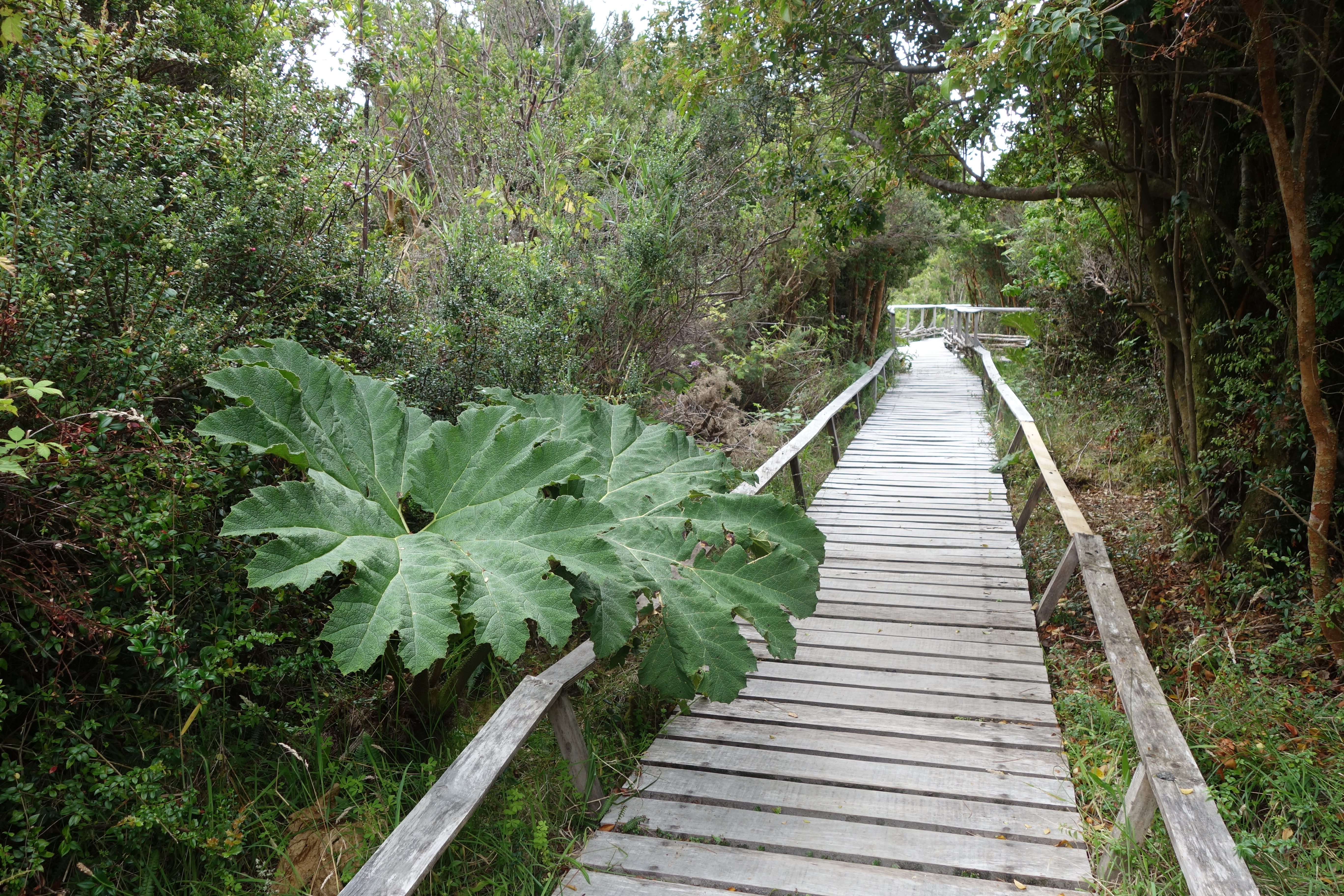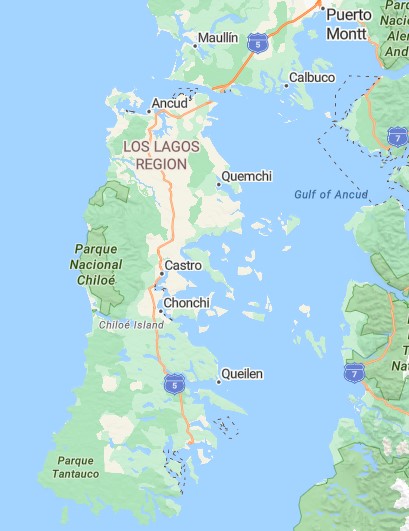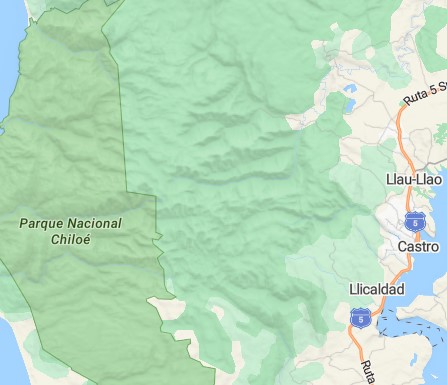
If you are limiting yourself to only parks maintained by the Chilean government’s park administration (CONAF), then your one stop on the archipelago can be the subject of this article, Parque Nacional Chiloé.
Large, centrally located, and closest to the hub of town of Castro, this is a one-stop shop for experiencing a bit of everything the archipelago’s biodiversity has to offer.
It is also the only park on the island to which there is regularly scheduled public transportation year-round, although only to one of the three entrances. This also doesn’t mean getting off the bus and into the park is easy. This is a huge park, and transportaton will only get you to the very edge, then you have a lot of hiking from there. But at least you can get there extremely cheaply.
Only camping and rustic shelters are available in the park, and most of those are along the coastline, about 1% of the park’s total area. The rest of the park is open, but it’s wilderness.
If you haven’t yet read up on some of the foundations of the entire seventeen-park route, go back and check out my overview post so you can get oriented.
Castro has its own regional airfield, but you won’t be able to get directly to it from an international airport. You would have to first fly to Puerto Montt, then from that airport inquire about local flights to Castro.
I would not recommend this, however, as you’ll spend more time looking for a local flight and waiting for it than by just getting to Castro on a bus. It’s not that far away.
In Puerto Montt, you can also reserve airport transfers to pick you up and take you to your hotel or to the bus station, or take you all the way to Castro.
The fee to access Parque Nacional Chiloé is 6,000 CLP for adults (~$7 USD), 3,000 CLP for youth (ages 12-17), and children under 12 are free.
The online option to pay the entrance fee is not available for this park. Payments are only accepted in cash at the park entrance.

You have two options where to start. The first is assuming you are following the route of parks in this series, and so you would already be in or around Castro in order to to have visited the previous park Tepuhueico. This makes it very easy to launch off to any of the three entrances to Park Chiloé, whether you’re going by public bus or a private transfer, as Castro is the closest starting point for all three.
If, however, you are starting your itinerary in Puerto Montt, the largest city of southern Chile, you can simply take a bus from Puerto Montt to Castro if you are aiming to enter at the southern or middle access points. If you’re headed from Puerto Montt to the northern access point of the park, you can take a bus from Puerto Montt to Ancud, and then arrange for a taxi to the river dock, and then on the other side of the river begin the 5-hour hike to the ranger station. Yeah, it’s only for the hardcore hikers.
If you’re starting from all the way up in Santiago, read our article on how to get to Puerto Montt by bus from Santiago, which also describes some top attractions to check out when you get there.
To make it even more convenient, we have private drivers available to get you from and to the Puerto Montt airport, or for full drives all throughout the Chiloé region.
I will be discussing all the transportation options in the Transportation Options section later in this article.


Open all year
Topography: Coastal Rainforest, marine coastal marshes and beaches
Climate: Rainy but mild
Chiloé National Park is a sprawling wilderness area comprising 42,567 hectares of the island’s prime territory. The park two main sectors: Chepu located to the north of the park associated with the northern entrance; and Abtao, which is part of the communes of Castro, Chonchi, and Dalcahue. Abtao has the southern and the middle entrances.
Chiloé National Park is richly endowed in terms of cultural heritage, with an emphasis on historical, ethnographic, and archeological sites, as well as interesting paleontological sites such as Rahue Beach. Adjacent to the park are Huilliche communities that keep their traditions alive and where visitors can learn about and appreciate the heritage of this native people. These communities are integrated into the development of the park, providing complementary services to visitors.

Among the species that are protected in the park are, among the flora: tepa, associated with olivillo and coigüe, luma, pitra and myrtle, larch and cypress of the Guaitecas. Also, an interesting aspect of the fauna of Chiloé is the presence of endemic species of mammals and birds, due to its insular condition. You can see the Chiloé fox, Chiloé mountain
monkey, Chiloé mole mouse, Chiloé tree mouse, pudú, sea otter, river otter and common sea lion. With respect to birds, it is possible to observe the Chiloé conch, Chiloé rayadito, Chiloé diuca, cuca heron, caranca, rock cormorant, southern pileated pilot, kestrel and black woodpecker.
Chiloé National Park has picnic areas, camping areas, hiking trails, viewpoints, and rustic shelters. There is also an for camping in the indigenous community of Chanquín, with basic equipment and reasonable prices.
|
Name
|
Distance
|
Hiking Time (round-trip)
|
Difficulty
|
Features
|
Open
|
|---|---|---|---|---|---|
|
Río Chepu-Río Lar
|
11 km
|
10 hours
|
Medium
|
Coastal trails, river experience, northern sector
|
All year
|
|
El Tepual
|
2 km
|
1 hour
|
Easy
|
Interpretive trail, good for families
|
All year
|
|
Dunas de Cucao
|
1,5 km
|
1 hour
|
Easy
|
Sand dunes
|
All year
|
|
Chanquín-Cole Cole
|
16 km
|
10 hours
|
Medium
|
forest, coast, indigenous lands access
|
All year
|
|
Río Cole Cole-Río Anay
|
6 km
|
3 hours
|
Medium
|
coastal dunes and trails, birds, ocean viewpoints from cliffs
|
All year
|
|
Castro-Abtao
|
18 km
|
2 days
|
Difficult
|
virgin forest, mountain range to coast, wildlife spottings
|
All year
|
The park is open daily 9:30 to 16:30, so you have to be out of the park by 4:30 p.m., or into the park by 4:30 p.m. if you are camping overnight. This makes the only practical bus departure times from Castro those that leave in the morning.
There are also some basic hotels and lodges at the entrance in Cucao, if you want to overnight there.
Even if you are taking the easier hikes at the southern entrance, the park is still so large that you should plan on a minimum of two days to cover getting there, getting around, and getting back to Castro. If you’re going on more lengthy hikes, then add on one or two days more.
Visiting between December and March are optimal times for the weather, and other times you should bring rain ponchos and extra changes of clothing to keep you dry. It doesn’t get really cold here, but the dampness can cause your body to ache and get sick, so staying dry is the key.
If your strategy involves needing private transportation, from Castro or Puerto Montt, we will be glad to coordinate that for you with our local contacts there. Just let us know through our contact form.
Public buses only go to the southern entrance of the park, which is called Cucao (pr. koo-KAUW) named after the small community there. To get to the middle entrance, read the By private shuttle section. To get to the northern entrance, read the section By bus and private combined to northern entrance.
For going to Cucao, there is no online reservations. You simply go to the Castro bus terminal and buy a ticket at the window of either the Buses Javiera or Buses Ojeda offices.
Buses Javiera has a larger sign above its office that says “Parque Nacional Cucao”, which is a perplexing misnomer, as there is so such park by that name, but what they mean is Cucao entrance to the Parque Nacional Chiloé. Departures are at 10, 11, 12, 13:30, 15:00, 16:30, 17:30, 19:00, and 20:00. The trip takes 90 minutes, and stops to pick up and drop off passengers in three other towns along the way.
The bus fare depends on the season, but it’s less than $5 USD.
Buses Ojeda has departures at 8:30, 9:30, 11:30, 13:00, 14:00, 15:30, and 18:00. It has the same trip time, price, and bus stops as Javiera.
To get back to Castro, simply go back to where the bus dropped you off in Cucao for departure times that are about 90 minutes later than your departure time from Castro.
Private shuttles can be arranged through our contact page. either from Castro or from Puerto Montt. Your budget should be a minimum of $175 USD for this option for a two-person car and a couple backpacks. It will be more if the distance being traveled is greater or the number of passengers and luggage is greater, or both.
Drivers can take you all the way to the Cucao entrance at the southern end, as this is paved road.
For the middle entrance, drivers will take you to the end of a gravel road that is W-480, about 30 minutes west of the highway from Llau-Llao. From there, you hike on foot another 2 hours to the park entrance. Hike another 8 hours over the Piuchén mountain range to the coastal area where you come to the mouth of the Curi and Abtao rivers. It is a most remarkable wilderness hike, but only meant for the most experienced hikers.
For the northern entrance, a private shuttle can take you as far as the ferry dock on the Chepu river, called “Muelle Chepu Alto”, which is on W-250. At the river dock you can hire a waiting boat down the river toward the coast. They let you off on a coastal trail that you hike south to the ranger’s station on the Lar river. Expect about 6-7 hours transportation and hiking included.
This might make things a little cheaper than a full private shuttle, but we can’t arrange the private shuttle aspect if you use this combined public/private option.
The public part, however, is easy, and you can reserve the ticket online. What you do is first get your bus ticket online from Castro to Ancud, or from Puerto Montt to Ancud.
Once you arrive in Ancud, just find a taxi around the terminal area or ask one of the bus station administrators for a recommended private driver to take you the 40 minutes more to the Muelle Chepu Alto, and then from there follow the hiking instructions in the last paragraph of the Private Shuttles section above.
For those who are following this Patagonia series of hikes and have already visited the other two parks, then I would recommend just going for the easier coastal hikes at the southern end, Cucao. You will have experienced much of the same natural landscapes in the other two parks, but the coastline in this park is unique.
The trekkers who are only going to be visiting Parque Chiloé and neither of the other two parks, I would suggest the treks of higher difficulty if that is something you can handle. The relative isolation and combination of landscapes and cultural exchanges to which you will be introduced make the longer amount of hiking time worth it. Even if you choose the bus option to the southern entrance, take the longer hikes so you can get a grander experience of the full biodiversity of Chiloé.
If you are on a tighter time schedule and you also are not up for a rigorous level of hiking, definitely just take the bus to Cucao in the morning and choose from the several easy trailheads that embark from the village, and you’ll still have a grand time.
South America Buses (SAB) is the luxury channel of AndesTransit, the land travel transportation schedule and reservation hub preferred most by travelers to Latin America. SAB has a select team of distinguished travel experts who have dedicated themselves to research, document, and curate routes and carriers in South America that meet nothing short of the highest quality standards in land travel.
Other Links
Copyright © 2024 SouthAmericaBuses. All rights reserved.
